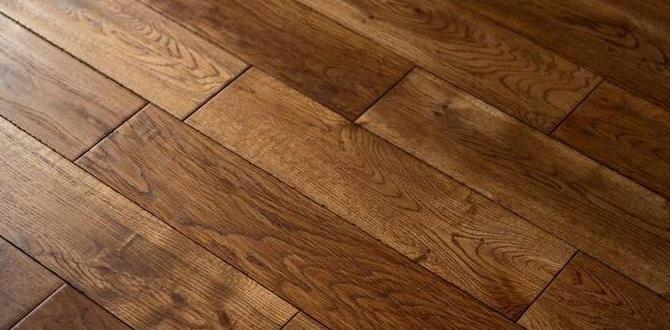Yes, you absolutely can nail through paint reliably. The key is using the right nailer type, proper technique, and a few simple preparation steps. Don’t let existing paint stop your project – we’ll show you exactly how to get a clean, strong hold every time.
Hey there, DIYers! Jack Shaffer here, your go-to guy for all things nail guns and woodworking. Ever stood there, project in hand, ready to secure that perfect piece, only to be met with a smooth, painted surface? It’s a common moment of hesitation. You wonder, “Will the nail just bend? Will it chip the paint badly? Will it even hold?” It can be frustrating and feel like an obstacle to finishing your project smoothly.
But here’s the good news: you can nail through paint, and it doesn’t have to be a messy or difficult job. With the right approach, you can achieve a clean finish and a secure hold, just like you would on bare wood. We’ve got a proven method that’s beginner-friendly and will give you the confidence to tackle any project, no matter how many layers of paint stand in your way.
We’ll walk you through everything you need to know, from choosing the right tool to the exact steps to follow for a perfect result. Get ready to learn how to nail through paint like a pro!
Table of Contents
Understanding the Challenge: Why Nailing Through Paint Can Be Tricky
When you’re working on a project that involves an already painted surface, like trim, furniture, or even a wall stud, you might run into a few hiccups if you’re not prepared. It’s not about the paint itself being incredibly strong, but rather how it interacts with the nail or staple.
Think about it: paint is a coating. When you drive a sharp object like a nail through it, the paint can sometimes:
- Chip or Flake: Especially if the paint is old, brittle, or not well adhered to the surface below. The force of the nail can cause it to crack outwards.
- Grab and Tear: A softer, more flexible paint might stretch and tear around the nail shaft, leaving enlarged holes.
- Cause Splintering: On wood, the combination of paint and wood fibers can sometimes lead to more splintering than if you were nailing into bare wood.
- Create an Unsightly Mark: Even if it doesn’t drastically chip, the point of impact might leave a noticeable discoloration or dent.
These issues are more likely with certain types of paint (like thick latex or older oil-based paints) and with less powerful tools or improper nailing techniques. But don’t worry, these are all manageable problems. We’re going to cover how to avoid them.
The Right Tool for the Job: Choosing Your Nailer
Your choice of nailer is crucial when working with painted surfaces. While a hammer and nails are always an option, a nail gun significantly speeds up the process and often provides a cleaner finish, especially for beginners. Different types of nailers excel in different situations.
1. Brad Nailers
Brad nailers are fantastic for finer woodworking tasks. They shoot thin, short nails (typically 16-gauge or 18-gauge) that leave a very small hole, making them ideal for trim, molding, and decorative elements. Because the nails are slender, they tend to penetrate paint with less force, minimizing chipping.
Pros:
- Minimal damage to paint.
- Small nail holes are easy to conceal.
- Lightweight and easy to maneuver.
- Great for delicate trim work.
Cons:
- Not strong enough for structural applications.
- Limited nail length and gauge.
2. Finish Nailers
Finish nailers use slightly thicker and longer nails (typically 14-gauge or 15-gauge) than brad nailers. They offer more holding power and are suitable for attaching thicker trim, baseboards, and window casings. They still leave relatively unobtrusive holes.
Pros:
- Good holding power for most trim jobs.
- Nail holes are manageable and easy to fill.
- Versatile for various woodworking projects.
Cons:
- Can cause slightly more paint damage than brad nailers on very brittle paint.
- Heavier than brad nailers.
3. Framing Nailers
Framing nailers are designed for heavy-duty construction work. They shoot large, thick nails (2×4-inch or longer) for framing walls, decks, and other structural components. While they will absolutely nail through paint, they are overkill for most DIY woodworking projects and will leave significant holes.
Pros:
- Extreme holding power for structural applications.
- Fastest nailing option.
Cons:
- Excessive damage to painted surfaces for typical DIY tasks.
- Very heavy and bulky.
- Large nail holes require significant filling.
Which One Should You Choose?
For most tasks involving nailing through painted trim, furniture, or cabinetry, a brad nailer or a finish nailer is your best bet. They offer the right balance of holding power and minimal damage. If you’re just starting out and want a versatile tool for trim and lighter projects, a 16-gauge finish nailer is often a great all-around choice.
The Proven Method: Step-by-Step Guide to Nailing Through Paint
Now that you’ve got the right tool, let’s get to the actual process. Follow these steps, and you’ll be nailing through paint like a seasoned pro in no time. Safety first, always!
Step 1: Safety Gear Up!
Before you even pick up your nailer, put on your safety glasses. Nail guns are powerful tools, and a ricochet or a stray nail can cause serious eye injury. Hearing protection is also a good idea, as nailers can be quite loud.
Step 2: Prepare Your Nailer
Ensure your nailer is loaded with the correct size and type of nails for your project. Check the air pressure on your compressor if you’re using an air-powered nailer. The recommended pressure is usually found in your tool’s manual, but a good starting point for finish nailers is often between 70-100 PSI. Too little pressure, and the nail might not fully set. Too much, and you risk more damage to the paint or wood.
Consult your nailer’s manual for specific PSI recommendations. For example, Bostitch, a reputable tool manufacturer, provides detailed guidelines for their tools, emphasizing the importance of correct air pressure for optimal performance and safety. You can find resources like the Bostitch Manuals page for specific guidance on their products.
Step 3: Choose the Right Nail Type and Size
As discussed, thinner nails (like those from brad and finish nailers) are better for painted surfaces. Use nails that are long enough to securely penetrate the material you are fastening into (e.g., trim into a stud), but not so long that they go all the way through and become a hazard or aesthetic problem on the other side.
Step 4: Test Fire on Scrap Material
This is a critical step often overlooked by beginners. Find a piece of scrap wood that has the same type and thickness of paint as your project. Use this to dial in your nailer’s depth adjustment (if it has one) and confirm the air pressure. Fire a few test nails.
Aim for the nail head to be slightly below the paint surface or perfectly flush. If the nail head is proud (sticking up), you need more power or a different setting. If it’s driven too deep, causing excessive splintering or a crater, you might need less power or a gentler approach.
Step 5: Position Your Nailer Correctly
Place the nose of the nailer firmly against the surface where you want to drive the nail. Ensure the contact trip (the part that fires the nail when pressed) is against the wood, not just the paint. This helps ensure the nail goes exactly where you intend it to.
Step 6: Drive the Nail
There are two main firing modes: single sequential trip and contact trip. For precision and to minimize accidental firing, use sequential trip mode (where you must press the nose to the surface before triggering the gun) for critical placements. For faster work, contact trip (fire by pressing the trigger, then hold the nose to the surface) can be used cautiously in less critical areas once you’re confident.
Press the trigger firmly and smoothly. Let the nailer do the work. Don’t force it. The nail should drive through the paint and into the material below with a satisfying thud.
Step 7: Check the Nail Head
Inspect each nail. Ideally, the head should be flush with the surface or sunk just a hair below the paint line. If the head is sticking out, you can gently tap it down with a nail set and hammer, being careful not to overdrive and damage the surrounding paint.
If a nail isn’t set properly or is causing too much damage, carefully remove it using a nail puller or the claw of your hammer. Then, try again, adjusting your nailer’s settings or air pressure as needed.
Step 8: Filling and Finishing
Once all your nails are driven, you’ll likely have small holes. For brad and finish nails, these are usually small enough to be filled with a good quality wood filler or putty. Choose a color that matches your paint or is stainable if you plan to paint over it.
Apply a small amount of filler to the nail hole. Let it dry completely according to the product’s instructions. Then, lightly sand the area smooth. If you’re painting, you can apply a primer and then your topcoat of paint. If you’re matching an existing finish, you may need a few coats of paint to ensure the filled area is completely invisible.
Tips for Minimizing Paint Damage
Even with the best technique, some minor paint disturbance is possible. Here are some extra tips to keep your painted surfaces looking as good as new:
- Use Lubrication Periodically: Some nailers benefit from a drop of pneumatic tool oil in the air inlet. Check your manual. This keeps the internal parts moving smoothly, ensuring consistent power.
- Keep the Nailer Clean: Dust and debris can impede your nailer’s performance, potentially leading to inconsistent nail driving and more damage.
- Work in Straight Lines: When nailing trim, try to keep your nailer perpendicular to the surface. An angled nail is more likely to bend or cause uneven damage.
- Consider Nail Spacing: Don’t overdo it with nails too close together, especially on thin material or brittle paint, as this concentrates stress. Space them appropriately for the job.
- For Tougher Paints: If you’re dealing with particularly thick or hardened paint, you might consider scoring a very light line around the nail point with a utility knife before firing. This can help to break the paint’s adhesion in a controlled way. Be very careful not to cut deeply into the wood.
- Patience is Key: Don’t rush the process, especially if it’s your first time. Take your time to position, fire, and check each nail.
When to Consider Alternatives (or Extra Steps)
While nailing through paint is usually effective, there are a few situations where you might want to think twice or take extra precautions:
- Very Old, Brittle Paint: If the paint is flaking off in large pieces already, driving a nail might exacerbate the problem significantly. You might need to repair or remove loose paint first.
- High-End or Delicate Finishes: For valuable antique furniture or highly decorative painted finishes, you might prefer to use specialized adhesives or very fine pins with minimal impact.
- Structural Integrity is Paramount: If the nail needs to bear significant weight or stress and the paint is compromised, carefully assess if a nail in a painted surface is the best solution.
In these cases, you might consider:
- Cleaning and Repairing Paint: Gently scraping away any loose paint around the intended nail location can help.
- Using a Different Fastener: Small screws might offer more controlled entry, especially if pre-drilled.
- Adhesives: For some applications, strong wood glues or construction adhesives can provide superior holding power without mechanical fasteners.
- Careful Pre-Drilling: For thicker nails or very hard wood under the paint, drilling a pilot
hole slightly smaller than the nail’s shank can help guide the nail and prevent wood splitting. This is less common with brad/finish nailers but can be useful for specific situations.
Comparing Nailing Methods: Nail Guns vs. Hammer and Nails
It’s worth briefly comparing the nail gun method with traditional hammer and nails when dealing with painted surfaces. Both have their merits, but nail guns usually win for efficiency and consistency.
Here’s a quick look:
| Feature | Nail Gun (Brad/Finish) | Hammer and Nails |
|---|---|---|
| Speed | Much faster, especially for multiple nails. | Slower, requires more physical effort. |
| Nail Placement Precision | Requires practice but can be very precise. | Highly controllable, but requires skill to hit consistently. |
| Paint Damage | Can be minimal with correct settings; risk of deeper denting. | Higher risk of hammer marks on paint around the nail head; nail head can be harder to set flush. |
| Nail Hole Size | Small, consistent holes. | Slightly larger and can be less uniform. |
| Learning Curve | Moderate (tool operation and settings). | Low (basic hammer use) to High (mastering flush setting without damage). |
| Holding Power | Good for trim/joinery. | Good, depends on driving depth. |
| Portability | Requires air compressor and hose (for pneumatic); battery models are more portable. | Highly portable. |
For DIY projects where speed and ease of use are important, and you want a consistent result, a nail gun is generally the superior choice when working through paint. The ability to adjust depth and use slender nails makes it very effective.
Conclusion
So, there you have it! Nailing through paint is not only possible but a standard practice in many woodworking and DIY applications. By selecting the right tool – typically a brad or finish nailer – and following a few simple steps, you can achieve clean, strong results every time. Remember to prioritize safety with protective gear, always test your settings on scrap material, and take a moment to fill and finish those nail holes for a truly professional look.
Don’t let a painted surface deter you from your next project. Whether you’re installing new trim, refreshing furniture, or tackling another DIY task, you’ve now got the knowledge and the method to drive fasteners through paint with confidence. Your projects will look great, and you’ll have the satisfaction of knowing you conquered another common DIY challenge.
Happy building, and remember, if you’ve got questions, the Nailerguy is always here to help steer you right!


